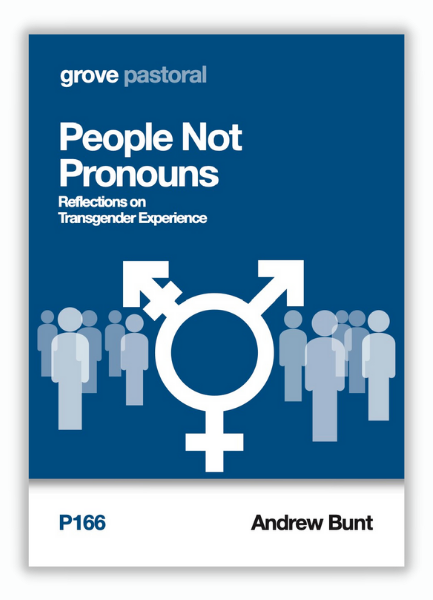Andrew Bunt, People Not Pronouns: Reflections on Transgender Experience (Grove Books, 2021)
The Transgender Issue. The Transgender Matter. The Transgender Agenda.
If your social media feed is anything like mine, then you’ll be very much aware of just how significant these phrases (and others like them) have become in our cultural moment. Talk about gender, sex and identity floods our newsfeeds, our entertainment and our conversations.
But as we find ourselves immersed in all the debates and discussions, we often forget that we are not ultimately talking about issues. Or matters. Or agendas. On each and every 'side' of each and every debate are people. Real-life, breathing, hurting, loving, laughing, crying, human people. Surely Christians – those who are called to love others as themselves – should be the first to recognise this vital truth. Yet so often, we sharpen our theological debating expertise while forgetting the importance of practicing love. This is precisely why Andrew Bunt’s short book, People Not Pronouns, makes such an important contribution to the Church’s thinking about transgender experience.
Behind the debates, behind the news stories, behind (and often not amongst) the activists are real people, people created by God and loved by God (p.5).
While Andrew's aim is modest and realistic, it is also profound. Instead of setting out to answer all the questions readers are likely to have about transgender and gender dysphoria, he focuses our attention on the broader principles able to guide our thinking. In particular, he argues that any Christian response to the transgender experience ought to have a threefold structure of head, heart and hope. As I read, I found it helpful to picture this as a triple helix – one unit formed of three individual strands, all of which circle around the one central axis of Jesus Christ and life in him.
First is the Christian’s Heart Response. By this Andrew means that truth must always go hand in hand with, and never apart from, love. And yet, because our world is just as confused about the nature of love as it is the nature of sex and gender, it is to the heart of Jesus that the author directs his readers’ gaze. ‘When we look at Jesus’, Andrew writes, ‘we see that he loved, and he loved even those whom others assumed he should hate’ (p.8). As those who have come to personally know that love and compassion of Christ, his disciples are called to turn that love and compassion outwards towards others.
If we find that our default response [to those who are transgender] is something other than love—perhaps disgust or anger—we must examine why this is, and allow the example of Jesus to challenge us and the Holy Spirit to change us (p.8).
Andrew next focuses on the Christian’s Head Response. In this section, he balances pastoral sensitivity with courageous truth-telling about the divergence between worldly and biblical notions of personal identity. The world teaches us that our own internal feelings and desires determine who the 'real me' is. This extends to and includes how we think of the 'real gendered me'. However, the Bible teaches us that our identity as either a man or a woman is something ‘we have received […] from God’ (p. 17). This means that ‘it is not possible to be born in the wrong body’ (p.17). Though he recognises that such things are genuinely difficult to say and perhaps even painful for some to hear, Andrew calls his readers to trust in a God who has supremely demonstrated his trustworthiness, goodness and wisdom.
 The final strand of the Christian response is the Hope Response. In this section Andrew urges his readers to understand the transgender and dysphoric experience as one shaped by the kind of grief and suffering which calls for a deeply relational, gospel-shaped response. Such an approach will be one which emphasises that no matter ‘how acute our experience of brokenness, there is always reason to hope because we know the end of the story. There is a day when all pain will end’ (p. 21). Here we see the promise of the gospel, providing those who experience such dysphoria with an overwhelmingly confident hope of the full resolution, restoration, redemption and resurrection found in Christ Jesus.
The final strand of the Christian response is the Hope Response. In this section Andrew urges his readers to understand the transgender and dysphoric experience as one shaped by the kind of grief and suffering which calls for a deeply relational, gospel-shaped response. Such an approach will be one which emphasises that no matter ‘how acute our experience of brokenness, there is always reason to hope because we know the end of the story. There is a day when all pain will end’ (p. 21). Here we see the promise of the gospel, providing those who experience such dysphoria with an overwhelmingly confident hope of the full resolution, restoration, redemption and resurrection found in Christ Jesus.
Heart. Head. Hope. This is what the Christian response to transgender experience – or more specifically, to transgender people – must be shaped and informed by. Andrew shows that far from any one of these three responses being independent of the others, they are actually all interdependent upon each other. That I found this approach so compelling perhaps explains why I was left a little uncertain of the intended meaning and implications of one particular comment in the book. In his opening line to A Hope Response, Andrew writes:
If the experience of those who live with gender dysphoria is primarily an issue of suffering rather than identity, how should we respond? (p 19).
Upon my first read I found this diminishment of the role of 'identity' in the discussion a little jarring. The reason for this was that Andrew had just spent the previous chapter arguing (and convincingly so!) that how we understand and apply 'identity' forms the theological crux of how we ought to think – and so respond wisely – on this topic. In particular, he had concluded that internally informed notions of identity don’t work and that the ‘better answer is in divine identity: identity given to us by God’ (p. 15). But just a few pages later he seemed to be suggesting that identity itself isn’t the primary issue related to the gender dysphoric experience. This left me a little confused and, in fact, actually resulted in me misinterpreting the author’s approach in this chapter.
Once I carefully reread the section in the context of the broader argument, I was able to understand that Andrew wasn’t contradicting himself. Rather he was suggesting that the framework through which the gender dysphoric person might apprehend and respond to their experience (and so also, how those who care for them might do the same) was not through the worldly framework of internal identity, but through a gospel framework that recognises the inevitability of our broken experience in this present creation.
However, I do think that, contrary to the author's comment quoted above, such a conclusion itself suggests that the experience of gender dysphoria (and the loving response to that experience) can’t not primarily be an issue of identity – specifically, of the pull between worldly identity and divine identity. I absolutely agree with Andrew's conclusion that the ‘Bible rarely gives indications as to the causes of specific sufferings’ (p. 22). And so, in no way do I want to suggest that there is always (or usually or often) a direct causal link to be drawn between a particular expression of sin and experience of suffering in someone’s life. And yet, it is also true that our own personal wrestling with the ways of this fallen world and the call of the divine upon us (on any and every matter in our lives, not just this one) is the context in which we each endure suffering. As a result – just like heart, head and hope – 'identity' and 'suffering' would seem to be interdependently linked with each other, rather than largely separable issues with different levels of primacy.
That one comment aside, Andrew's book is a masterful exhortation for Christians to love transgender people the way that Jesus loved those he met, namely as beloved creations of God who have been made in his image. The triple-helix of heart, head and hope dance together in perfect harmony and guide the reader to love as our Saviour loved – with compassion and in truth. Andrew spurs us on to see transgender and gender dysphoric people as people, and so to walk alongside them with deeply human understanding, love, and support. He equips us to truly ‘show our love towards transgender people, but much more than that […] to show God’s love’ (p.25).




